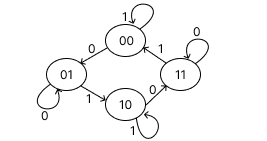2075
Digital Logic
Full Marks: 60
Pass Marks: 24
Time: 3 hours
Attempt any two questions: (2 x 10 = 20)
- Implement the following function F = ∑(1,2,3,4,8) using
- (a) Decoder
- (b) Multiplexer
- (c) PLA
- Design clocked sequential circuit of the following state diagram by using JK flip-flop.

- The following is a truth table of a 3-input,4 output combinational circuit. Tabulate the PAL programming table for the circuit and mark for the circuit and mark the fuses to be blown in a PAL diagram.

Attempt any eight questions: (8 x 5 = 40)
Convert the following decimal numbers to the indicated bases.
- (a) 7562.45 to octal
- (b) 1938.257 to hexadecimal
- (c) 175.175 to binary
Express the Boolean Function F = A + B’ C in a sum of minterms .
Reduce the following function using k-map
F = B’D + A’BC’ + AB’C + ABC’
Design a combinational circuit with three inputs, x, y, and z, and three outputs, A, B, and C. When the binary input is 0, 1, 2, or 3, the binary output is one greater than the input. When the binary input is 4, 5, 6, or 7, the binary output is one less than the input.
Implement half adder using 2-4 decoder.
Design the priority encoder circuit.
What is the difference between a serial and parallel transfer? Explain how to convert serial data to parallel and parallel data to serial. What type of register is needed?
Design a 4-bit binary ripple counter with D flip-flops.
Write short notes on (any two):
- (a) SIMM
- (b) RTL
- (c) Parity Checker